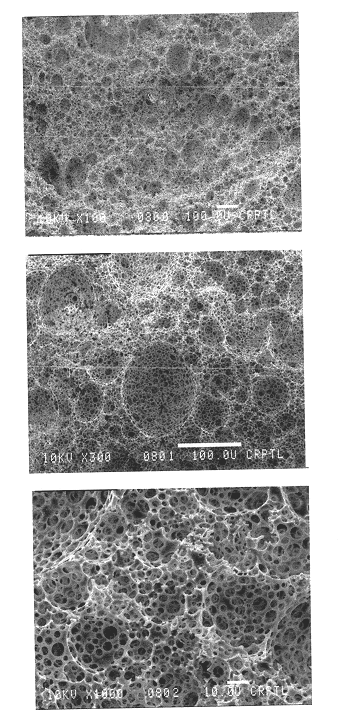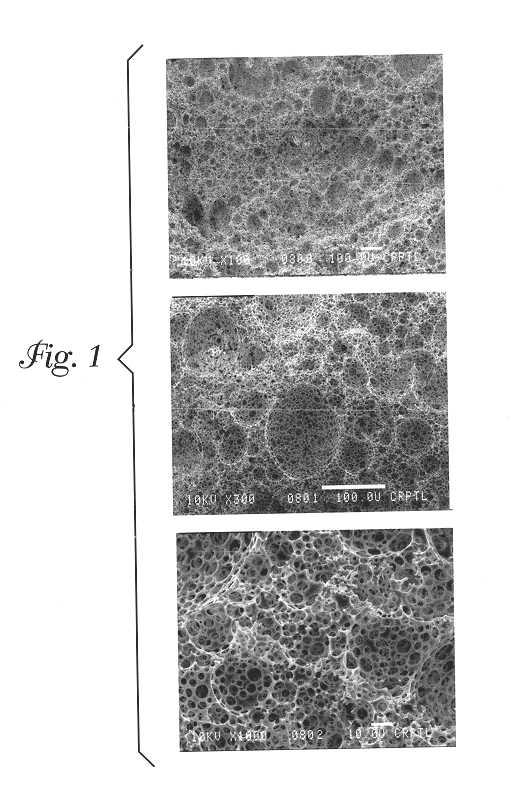Foams made by photopolymerization of emulsions
a technology of emulsion and foam, which is applied in the direction of film/foil adhesives, domestic applications, undergarments, etc., to achieve the effect of bulk density
- Summary
- Abstract
- Description
- Claims
- Application Information
AI Technical Summary
Benefits of technology
Problems solved by technology
Method used
Image
Examples
example 1
Example 1 describes a batch process for making the foam emulsions of the present invention. The oil phase consisted of twelve grams of isobornyl acrylate (SR 506, Sartomer Co., Exton, Pa.), 69 grams of 2-ethyl hexyl acrylate (Aldrich Chemical Co., Milwaukee, Wis.), 15.1 grams of sorbitan monooleate (Aldrich Chemical Co., Milwaukee, Wis.), 12 grams of trimethylolpropane triacrylate (TMPTA-N, UCB Chemicals, Smyrna, Ga.), and 7.8 grams of DAROCUR 4265 (Ciba Geigy, Hawthorne, N.Y.), which were added to a glass jar and mixed by hand. This mixture comprised the oil phase mixture. 51.69 grams of this oil phase mixture were placed into a plastic tri-pour beaker. The mixture was agitated continuously with a Jiffy Stirrer (an air-driven impeller containing a Jiffy Stir mixing attachment, Cole Parmer item number P-04541-00, Vernon Hills, Ill.). The rotational speed of the Jiffy Stirrer was affected by the viscosity of the medium being stirred, so the rotational rate of the Jiffy Stirrer was ne...
examples 2 and 3
were made by mixing isobornyl acrylate (0.4020 grams), 2-ethyl hexyl acrylate (2.2984 grams), SAM 211-80 (0.4995 grams, BASF, Mount Olive, N.J.), trimethylolpropane triacrylate (0.4067 grams), and DAROCUR 4265 (0.2448 grams), in a glass beaker by hand to create an oil phase mixture.
The oil phase mixture was agitated during emulsion preparation with a magnetic stir plate (Catalog Number 58935-351, VWR Scientific, Chicago, Ill.). Deionized water (25.90 grams) was added dropwise (approx. 1 drop per second) to the oil phase during agitation via a separatory funnel mounted over the stir plate. A homogeneous, opaque emulsion was prepared by this method. Example 2 comprises one half of the emulsion removed after the water addition was complete. Example 2 was polymerized immediately, using the same method described in Example 1. Example 3 comprises the other half of the emulsion. It received some additional agitation using a three-blade air-driven impeller for less than one minute. After th...
examples 4-9
Examples 4-9 were made from the same emulsion but each example was allowed to age for a different length of time before polymerization.
PUM
| Property | Measurement | Unit |
|---|---|---|
| wavelengths | aaaaa | aaaaa |
| density | aaaaa | aaaaa |
| weight % | aaaaa | aaaaa |
Abstract
Description
Claims
Application Information
 Login to View More
Login to View More - R&D
- Intellectual Property
- Life Sciences
- Materials
- Tech Scout
- Unparalleled Data Quality
- Higher Quality Content
- 60% Fewer Hallucinations
Browse by: Latest US Patents, China's latest patents, Technical Efficacy Thesaurus, Application Domain, Technology Topic, Popular Technical Reports.
© 2025 PatSnap. All rights reserved.Legal|Privacy policy|Modern Slavery Act Transparency Statement|Sitemap|About US| Contact US: help@patsnap.com



